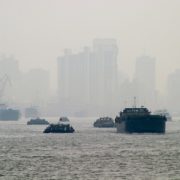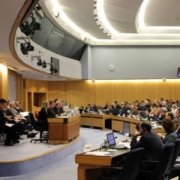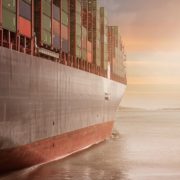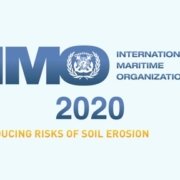GHG Emissions Policy Gets Varied Response from Environmental and Ocean Freight Shipping
Guidelines for Change Still Controversial – Too Little or Too Much?
Nobody could accuse the International Maritime Organization (IMO) of rushing into a decision regarding its avowed intent to cut pollution from cargo and passenger vessels. The greenhouse gas (GHG) emissions legislation has caused controversy since first suggested and has been something of a no win situation fparor the IMO as shipping lines, the freight community and environmentalists have all been publicising their views. On Friday April 13 we finally heard what the IMOs ‘Initial Strategy’ is to be, and the controversy, although muted, continues.
The IMO Marine Environment Protection Committee (MEPC) has announced that all participating member states have now finally agreed to reduce CO2 emissions as against 2008 levels by 50% by the year 2050. This decision comes after heated lobbying from all sides and has variously been hailed as ‘landmark’, ‘realistic’ and ‘far from perfect’ depending on who you listen to.
One has to have some sympathy with the IMO on this, it was always going to be impossible to please everybody and whilst viewed as a lumbering monolith by some, others consider the organisation the only chance to make collective decisions which have a truly global influence. Whatever your view, the details of Friday’s decision make it plain there is still a long way to go.
The new agreement comments that shipping must strive to assist in reaching the aim of the Paris Climate Agreement’s temperature goal, keeping the rise in global warming well below 2° C. Critics will say that the new agreement lacks detail with no specifics regarding timeframe for the reductions and this is a table of ambition rather than a prescriptive policy. Regulations will only be drawn up after yet another two rounds of studies due for completion by 2022.
IMO Secretary-General Kitack Lim hinted that, despite resistance from several states, progress was already being made. The move toward cleaner ships is already under way as technology progresses and some will see a degree of prevarication in the IMO’s stance, simply waiting for the industry to sort the problem itself. He commented:
“I encourage you to continue your work through the newly adopted Initial GHG Strategy which is designed as a platform for future actions. I am confident in relying on your ability to relentlessly continue your efforts and develop further actions that will soon contribute to reducing GHG emissions from ships.”
Just as the use of emission scrubbers, lower sulphur fuels and electrically powered vessels help with air quality, so the steadily rising amount of goods transported has the opposite effect. Last week we heard environmental operation Transparency International roundly criticise IMO policy, saying the industry holds too much sway over the organisation. Certainly the International Chamber of Shipping (ICS) which called for a 50% reduction, rather than the more swingeing cuts which some states preferred, seems to have got its way.
ICS says that the efficiency goal that has been agreed by IMO Member States for the sector as a whole, a 40% improvement by 2030, compared to 2008, and a 50-70% improvement by 2050, is extremely ambitious but probably achievable. But only if governments recognise the enormity of this challenge and facilitate the rapid development of new technologies and fuels. ICS Secretary General Peter Hinchliffe commenting:
“This is a ground breaking agreement, a Paris Agreement for shipping, that sets a very high level of ambition for the future reduction of CO2 emissions. We are confident this will give the shipping industry the clear signal it needs to get on with the job of developing zero CO2fuels, so that the entire sector will be in a position to decarbonise completely, consistent with the 1.5 degree climate change goal.”
“The agreed IMO objective of cutting the sector’s total GHG emissions by at least 50% before 2050, as part of a continuing pathway for further reduction, is very ambitious indeed, especially when account is taken of current projections for trade growth as the world’s population and levels of prosperity continue to increase.”
The UK Chamber of Shipping lauded the agreement and set out the view of many UK shipping groups whilst emphasising the size and importance of the sector. CEO Guy Platten said:
“This agreement commits the shipping industry to reducing its carbon emissions by at least 50% by 2050. But crucially this should be seen as a stepping stone towards decarbonisation in the long term, something which must be continue to be a major focus in the years ahead. Shipping moves 90% of global trade, and people understand the link between trade and prosperity, but rightly they demand we do it in a sustainable and responsible way. Climate change is real and we have a responsibility to play our part in preventing further damage to the environment.
“The shipping industry has already made great strides. Battery-powered ferries operate in Scotland, Scandinavia and elsewhere. Huge investment has gone in to better hydrodynamics, more efficient engines and lower carbon fuels. But make no mistake, these marginal gains alone are not enough to meet the 50% target, and certainly will not be enough meet the public’s expectations of a more fully decarbonised industry.”
“In truth, there is widespread understanding that in the long-term the industry needs to be powered by carbon-free fuel, and that will almost certainly mean a mix of battery, hydrogen and other zero-carbon fuels. Whilst battery and hydrogen cell technology does exist, their current capabilities are not sufficient to become the dominant fuels of the industry at this time. So research and development is now required on a massive scale.
“Last year the UK Government put £250 million of investment into battery R&D but that was targeted almost exclusively at the automotive sector. We need to see that kind of government-industry collaboration now applied to the shipping industry. Other countries are already investing heavily in developing carbon free fuels for ships.
”The UK could, of course, leave them to it. But if the future vision for the industry includes much greater use of carbon free fuel in international shipping, having that technology developed in the UK will mean huge opportunities to create jobs and generate wealth. The UK Government should pledge therefore to make the UK a world leader in carbon free fuels through investment in research and development.”
The international view was put by the World Shipping Council (WSC) which welcomed the agreement calling it ‘an ambitious strategy’ whilst requesting the IMO now initiates a formal Research and Development Programme itself. This was initially proposed when the WSC, and other organisations, submitted a paper last year to MEPC describing the need for a substantial, focused, and sustained programme. WSC President and CEO John Butler took the long view on reducing GHG emissions from shipping, saying:
“As hard as it was to reach political agreement this week, what comes next will be harder. We have to shift from a political mindset to an engineering mindset. There are no quick fixes here, but we can solve this problem. To do that we must establish a maritime research and development effort that will deliver the tools necessary to transform the industry. That is the next step for the IMO.”
For its part BIMCO says it is very satisfied with the strategy and that change in the industry was already well under way with emissions now decoupled from the growth in the world economy. The organisation, the largest of the international shipping associations representing ship owners with 56% of the world’s fleet by tonnage on its books says it sees zero carbon emissions as a realistic goal for the second half of this century, but reiterated that investments in research and technology are required to get there. Deputy General Secretary, Lars Robert Pedersen, commented:
“In BIMCO we believe that the industry can deliver on this target, even if we don’t exactly know how, yet. The strategy shows that there is only one road ahead, and that is the road towards decarbonisation. The strategy reinforces existing IMO regulations to enhance the energy efficiency of ships and sets out the long-term goals. This will guide the development of new technology and the design of new ships. Now we have to focus on the mid-to-long term. We have to find the technology and procedures that will drive us towards zero GHG emissions.”
Even environmental pressure group Greenpeace was receptive to the proposals but said that although the deal lists possible mitigation measures, the lack of an action plan for their development and the tone of discussions at the IMO does not give the organisation much confidence that measures will be adopted soon. Greenpeace urges the industry to transform these goals into concrete, urgent steps to decarbonise in full as soon as possible and by 2050 at the latest. Greenpeace International political advisor Veronica Frank, observed
“The plan is far from perfect, but the direction is now clear, a phase out of carbon emissions. This decarbonisation must start now and targets improved along the way, because without concrete, urgent measures to cut emissions from shipping now the Paris ambition to limit warming to 1.5 degrees will become swiftly out of reach.
“The IMO plan is a first step in the right direction, but much more needs to be done to achieve climate stability. The initial deal will be revised in 2023 and reviewed again in 2028, giving opportunities to strengthen the targets.”
Source: Handy Shipping Guide






